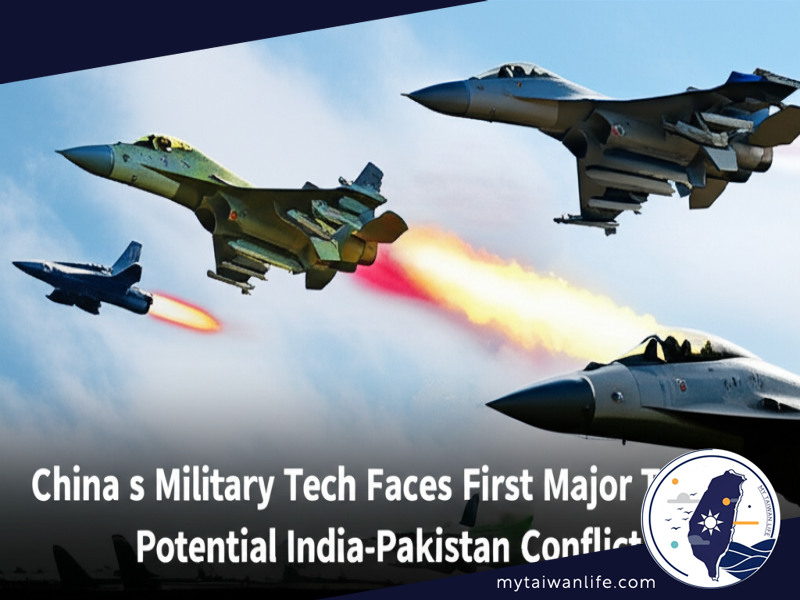China's Military Tech Faces First Major Test in Potential India-Pakistan Conflict
As tensions rise between India and Pakistan, the world watches to see how Chinese military technology performs against Western hardware.

The escalating conflict between India and Pakistan may be the first real test of advanced Chinese military technology against proven Western hardware. This comes as shares of China’s AVIC Chengdu Aircraft rose significantly after Pakistan claimed it used AVIC-produced J-10C fighter jets to shoot down Indian combat aircraft during an aerial battle. India has not responded to Pakistan’s claims.
China, a rising military superpower, has focused on modernizing its armed forces under Xi Jinping, investing heavily in sophisticated weaponry. This modernization extends to Pakistan, a key ally and China's primary arms recipient. Over the past five years, China has supplied 81% of Pakistan’s imported weapons, including advanced fighter jets, missiles, and air-defense systems. Some of these weapons have been co-developed with Chinese firms.
“This makes any engagement between India and Pakistan a de facto test environment for Chinese military exports,” said Sajjan Gohel. Joint military exercises between China and Pakistan further highlight this strategic partnership. Craig Singleton notes that Beijing's support for Islamabad has shifted the tactical balance, shaping regional deterrence.
This situation underscores a broader geopolitical realignment, with China challenging American influence in the region. India has drawn closer to the US, increasing arms purchases from the US and its allies, while Pakistan has deepened ties with China, becoming a key participant in Xi’s Belt and Road Initiative. The US and China each supplied about one-third of Pakistan’s imported weapons in the late 2000s. But Pakistan has stopped buying American arms in recent years and increasingly filled its arsenal with Chinese weapons.
With Pakistan largely armed by China and India sourcing weapons from the US and its allies, any conflict could become a test of Chinese and Western military technologies. After escalating tensions, India launched missile strikes targeting what it said was "terrorist infrastructure" in Pakistan and Pakistan-administered Kashmir. Pakistan claimed to have shot down multiple Indian fighter jets using J-10C fighters.
“If … confirmed, it indicates that the weapon systems at Pakistan’s disposal are, at the minimum, contemporary or current compared to what Western Europe (especially France) offers,” said Bilal Khan. If confirmed, the success of the Chinese-made weapon systems would be “a tremendous boost of confidence in Chinese weapon systems,” said Zhou Bo. “It will potentially be a huge boost for Chinese arm sales in the international market,” he said.
China ranks fourth globally in arms exports, with nearly two-thirds going to Pakistan. Experts suggest this success could attract interest from countries in the Middle East and North Africa. Experts in Pakistan and China say the J-10Cs deployed by the Pakistan Air Force are likely to have been paired with the PL-15, China’s most advanced air-to-air missile.
However, some experts caution that India's losses might stem from poor tactics rather than advanced Chinese weaponry. Rules of engagement may also have impacted the outcome. It is also important to consider whether the Indian side had any knowledge of the PL-15 missile or had misjudged its range. In the case of Indian missiles that were successful against Pakistani targets, this could also highlight the effectiveness of Chinese surface-to-air missiles in the area.
Other Versions
Error: All DeepL API keys exceeded 95% usage.
Error: All DeepL API keys exceeded 95% usage.
Error: All DeepL API keys exceeded 95% usage.
Error: All DeepL API keys exceeded 95% usage.
Error: All DeepL API keys exceeded 95% usage.
Error: All DeepL API keys exceeded 95% usage.
Ang Teknolohiyang Militar ng Tsina ay Haharap sa Unang Malaking Pagsubok sa Potensyal na Salungatan ng India-Pakistan
Error: All DeepL API keys exceeded 95% usage.
เทคโนโลยีทางทหารของจีนเผชิญบททดสอบครั้งใหญ่ครั้งแรกในความขัดแย้งระหว่างอินเดีย-ปากีสถ�
Công nghệ quân sự Trung Quốc đối mặt thử thách lớn đầu tiên trong xung đột tiềm tàng Ấn Độ-Pakistan

